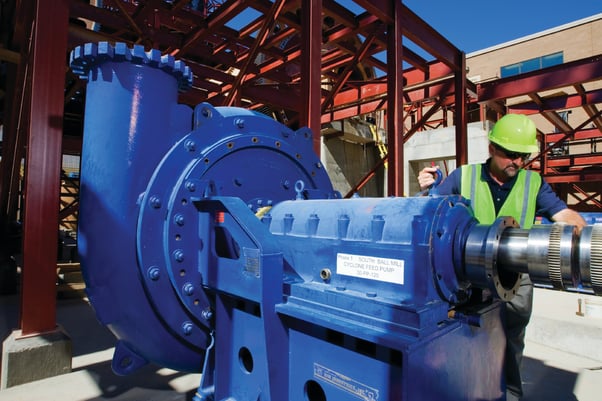
If you’re struggling with the wear life of your pump’s parts, you may not be operating optimally. Use these tips to boost your efficiency and reduce maintenance costs.
An optimized pump and slurry system can make or break a business in the Canadian Oil Sands. Costing up to $100,000 per hour due to lost production, it’s no secret that sites plagued by frequent shutdowns, pump malfunctions, or constant parts replacements struggle to control costs.
To ensure your pumps aren’t responsible for putting a strain on your bottom line, it’s important to check that they’re operating as intended. One key area to focus on is your suction liners. Since pump speed directly relates to suction liner failure — suction liners wear out faster in higher-speed pumps — it’s necessary you manage wear life so you can coordinate suction liner replacement with scheduled downtime to reduce costs.
You’ll also need to monitor and adjust your pump’s nose gap, or the space between the suction liner and impeller. Since your nose gap increases with pump use, checking it once per week is best. With a properly distanced nose gap — as close to the impeller as possible without touching it — you can increase the wear life of your parts two to threefold.
If, however, you find that the wear life of your pump and its parts are much lower than expected, a simple operating error could be to blame. Call an industry professional to check that your flow rates and operating conditions are ideal for the pump make and model.
If everything is operating as intended and you’re still experiencing issues, you may be dealing with a pump that is worn out or unfit for your application.
When you’re faced with the decision of performing ongoing repairs and parts replacements or purchasing a new pump, remember that choosing the right pump and other system equipment from the get-go can make a huge difference in your production capabilities and expenses:
- Increased equipment reliability — Shutting down a failing or underperforming pump isn’t just time consuming. It’s also expensive. A reliable pump means no unplanned shutdowns for the sake of slurry system repairs.
- Reduced maintenance costs — Repetitive parts replacements and frequent maintenance add up. With a pump that promises to last longer, you’ll spend less on labor hours and repairs.
- Decreased capital spending — It’s common to use a pump until it stops working entirely; however, pumps that are years — even decades — old are missing integral upgrades and technology that make newer pumps much more efficient, cost-effective, and easier to adjust and repair. Investing in the right pump upfront means spending less over the long run.
For professionals working in the Oil Sands, these three standards aren’t just ideal — they’re necessary. When you’re contending with remote conditions and high production standards, the last thing you want to worry about is an unplanned shutdown to handle an underperforming pump.
While a larger pump won’t help you reduce wear and, in fact, pumps too large for their applications can actually increase wear, an expert can help you find the perfect pump when it comes time to replace. Matched to an optimized slurry system that results in longer, more predictable wear life, your pumps and parts won’t just make a difference in your schedule and output — they can improve your profit margin, too.
Looking for a pump that will optimize your entire slurry system? KSB GIW, Inc. has you covered. In addition to cutting-edge design and technology, our GIW® MDX and WBC pumps feature adjustable suction liners, which maximize productivity and minimize costs by matching operating cycle times with scheduled mill outages. To learn more about these pumps or what KSB GIW, Inc. can do to help you optimize your current system, give us a call.
